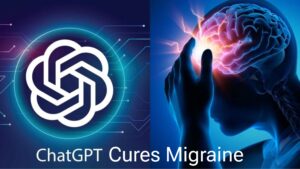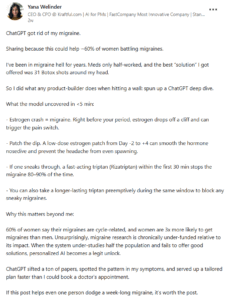For others, migraines are more than bad headaches—they’re disabling diseases that can stop people in their tracks and come with little or no relief. Yana Welinder, the creator of Kraftful, had a recent breakthrough about ChatGPT, the AI chatbot created by OpenAI, which was reported widely: It informed her about the cause of her long-standing migraines—something years of meds and doctor’s appointments hadn’t achieved. Her story brings forward a powerful intersection of technology and personal health, sparking conversations around AI’s role in diagnostics and wellness.

A Life Plagued by Migraines
Yana Welinder, a tech startup founder and entrepreneur, had allegedly suffered from chronic migraines for years. Like many sufferers, traditional medicine provided her with little relief. She mentioned that the prescribed drugs only succeeded partially, and some of the “solutions” were traumatic and agonizing. Indeed, one of the procedures entailed 31 Botox injections around her head—a popular cure for chronic migraine patients, but far from a panacea.
Migraines are a multifaceted neurological disorder that impacts more than 1 billion individuals worldwide. They’re frequently caused by a mix of genetic, hormonal, dietary, and environmental influences, and it may be like finding a needle in a haystack to determine the precise cause. Patients commonly waste years going round and round through medications, specialists, and therapies with only temporary relief.
How ChatGPT Made the Difference
In a post on social media, Yana indicated that she sought a recommendation from ChatGPT—OpenAI’s conversational AI. What she got was not just generic information but something much more effective: a pattern recognition of her symptoms, and a plan for her condition. According to Yana, it was a good note in that the chatbot examined her symptom patterns and produced insights faster than the time it would have taken to schedule an appointment with a regular doctor.
Though ChatGPT is not an official medical practitioner and can never substitute medical consultation, the fact that it can integrate enormous amounts of medical literature and identify patterns between symptoms and possible causes was life-altering for Yana.
AI and Symptom Pattern Recognition
What exactly made ChatGPT so useful in this particular situation? Ultimately, ChatGPT is centered around a gigantic dataset of medical journals, scholarly papers, and publicly available health data. With a user feeding in detailed descriptions or symptoms of health issues, ChatGPT can utilize natural language processing (NLP) to cross-referencing input and provide realistic conditions, causatives, or lifestyle modifications.
With Yana, ChatGPT likely caught on to nuance symptoms and lifestyle features that were perhaps neglected or less of a priority at clinical consultations. By so doing, it created a specific migraine treatment strategy, perhaps making recommendations regarding diet, hydration levels, sleep hygiene, stress techniques, or maybe medical topics to discuss with a health care practitioner.
The Power and Limitation of AI in Healthcare
This event fills both hope and fear. On the one hand, it reflects on the great ability AI technology such as ChatGPT has to assist patients, particularly those who have long-term illnesses that are hard to diagnose or treat. AI can also be a helper tool that can assist patients to learn things, ask proper questions, and get informed better.
Conversely, it is important to understand that AI algorithms such as ChatGPT are not exposed to real-time individual health information unless provided willingly and do not conduct clinical evaluations, laboratory studies, or physical examinations. Their recommendations must always be verified by qualified medical practitioners prior to implementation.
But such an integration of human healthcare and AI insights has the potential to revolutionize the way we go about well-being. Rather than replacing physicians, AI can support their abilities by providing patients with more context and understanding.
The Future of AI in Personalized Health
Yana’s experience is not unique. Increasing numbers of people are using AI tools to learn about symptoms, investigate possible causes, and enhance self-care practices. In an era where it can be difficult to get medical appointments and fragmented care is the norm, AI offers a consistent, always-present companion that can assist users on their health journey.
We’re also seeing a growing number of startups and healthcare platforms integrating AI to offer predictive diagnostics, manage chronic diseases, and even assist with mental health. AI’s strength lies in its ability to handle vast amounts of data and identify trends that the human mind may miss.
All the same, regulatory and ethical frameworks are catching up. Overreliance, misinformation, and misinterpretation continue to be threats, so transparency, professional supervision, and user education are important.
A Message to Chronic Migraine Sufferers
For those of us suffering from migraines, Yana’s experience provides a shining beam of hope. AI is no silver bullet, but it could help identify triggers, suggest coping mechanisms, or even provide under-the-radar treatment options. If you’ve been stuck in “migraine hell” for decades, as Yana put it, perhaps an AI helper would serve as a way to nudge you off course—no substitute for medical guidance, but a means of empowerment.
Also Read: HMPV Virus! Similarity With Corona Virus
Yana Welinder’s encounter with ChatGPT is not merely an individual health achievement; it’s a compelling story about how technology can insinuate itself into our lives in private, life-changing manners. It reminds us that, sometimes, the epiphanies arrive in the most unlikely of places—not a hospital or a laboratory, but a chat with a computer program.
As AI technology becomes increasingly embedded in everyday life, such tales lead us to wonder: How do we use these tools responsibly for improved health outcomes? And how do we make them accessible, safe, and effective for everyone?
For now, it appears the future of health may be only a few keystrokes away.

